When it comes to the perfect brisket, I look for a few key factors: tenderness, juiciness, a hint of smoke flavor, and that desirable thin bark. Well, this smoked brisket recipe, featuring the Pit Barrel Cooker, checks off all the boxes, and I can’t wait to share it with you!
I want to be upfront with you – this post contains affiliate links that help support our site. So, when you use those links, you’re also supporting us, and we appreciate it!
Now, let’s talk brisket. The beauty of cooking a whole brisket is that it can be as simple or as intricate as you like. You have the freedom to tweak every step to your heart’s content. I’ll do my best to explain each part thoroughly so that you can craft your very own preferred method for cooking a whole packer brisket. Because, after all, your way is the best way.
Let’s talk about injecting a beef brisket!
Injecting a beef brisket is like a double win. First, it infuses delicious flavors deep into the meat. Second, it replenishes the moisture that might otherwise be lost as it cooks. However, when you’re dealing with a smaller brisket, like the one we’re working with in the Pit Barrel Cooker, it tends to hold onto its moisture quite well. So, for this particular cook, you can skip the injection step – your brisket’s got it covered!
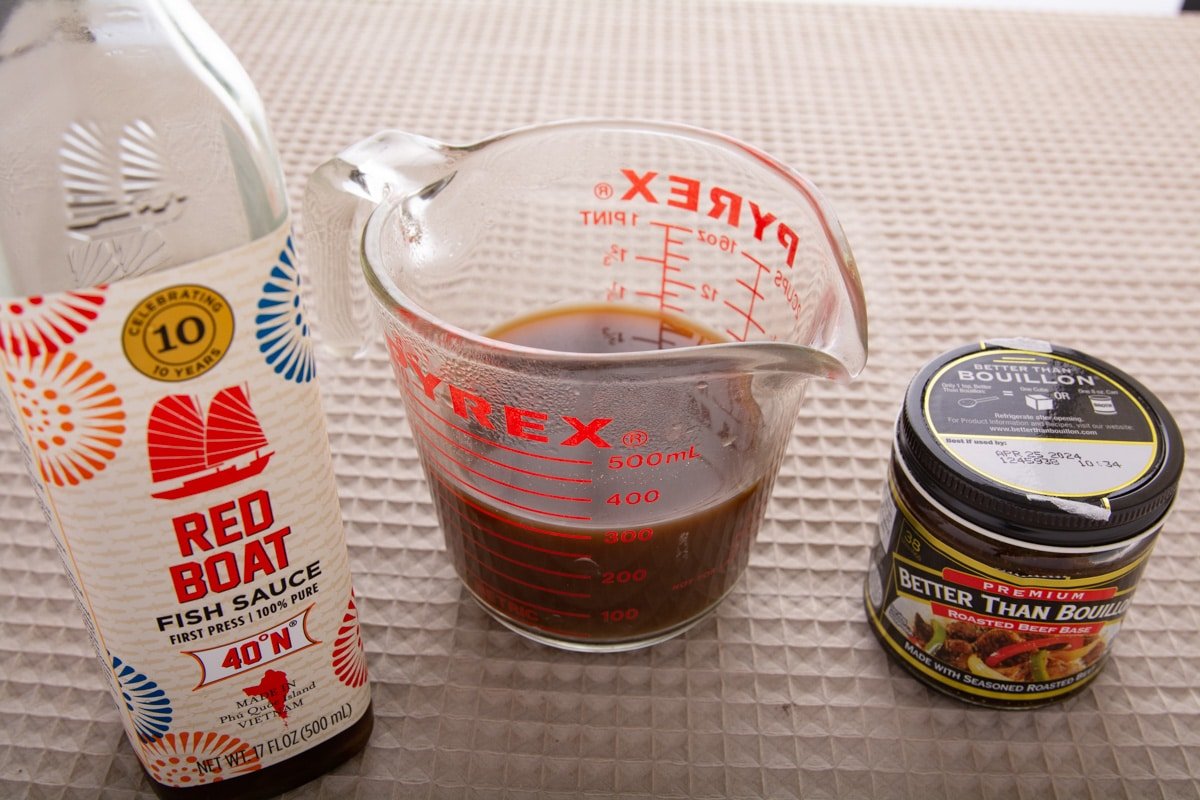
Brisket injection recipe
When it comes to beef injection, nailing the flavor profile is key! You’ll want it to be richly beefy (that’s a given), with a touch of saltiness, and a delightful umami kick. Umami is that savory, mouthwatering taste that can come from naturally occurring glutamates or the processed version, monosodium glutamate (MSG).
Personally, I like to keep things pretty straightforward but don’t be afraid to get creative and experiment to find the perfect blend that suits your taste buds. After all, it’s all about making it your own culinary masterpiece!
Using beef base in your brisket injection offers a robust and concentrated beef flavor. It’s like a flavor booster that enhances the natural beefy goodness of your brisket. Beef base is packed with savory richness, and it’s an excellent way to infuse that mouthwatering taste deep into the meat. So, it’s not just about adding more beef flavor; it’s about elevating the overall taste of your brisket to a whole new level!
Adding soy sauce to your brisket injection serves a couple of delicious purposes. First and foremost, soy sauce contributes a salty and savory depth of flavor that complements the beef beautifully. It enhances the umami notes in your brisket, making it even more irresistible.
Secondly, soy sauce can bring a touch of complexity and complexity to the injection mixture. Its unique blend of salty and slightly sweet elements can create a well-rounded flavor profile that tantalizes the taste buds.
In essence, soy sauce isn’t just about saltiness; it’s about elevating the overall taste and adding a layer of depth to your brisket, resulting in a mouthwatering masterpiece.
Worcestershire sauce can be a fantastic addition to your brisket injection for several reasons. This flavorful sauce adds depth, complexity, and a unique blend of savory and tangy notes to your brisket, enhancing its overall taste profile. Here’s why using Worcestershire sauce in brisket injection is a great idea:
While fish sauce may not be a typical ingredient for a brisket injection, some chefs and pitmasters do use it for a unique twist. Here’s why you might consider using fish sauce in your brisket injection:
- Umami Boost: Fish sauce is renowned for its intense umami flavor, thanks to the fermented fish used in its production. Adding a small amount can significantly enhance the overall umami profile of your brisket, making it even more savory and satisfying.
- Saltiness: Fish sauce is quite salty, and it can contribute to the overall saltiness of your injection mixture. This can help season the meat and enhance its natural flavors.
- Complexity: Fish sauce has a depth and complexity that can add a unique dimension to your brisket. It’s not just about salt; it brings a rich, savory, and slightly funky character to your meat, creating a distinctive and memorable taste.
- Experimentation: Using fish sauce is a way to experiment with flavors and try something unconventional. It can add an unexpected twist to your brisket that sets it apart from more traditional recipes.
That said, it’s essential to use fish sauce in moderation, as it has a strong and distinctive taste. It may not be to everyone’s liking, so consider your audience and their preferences when deciding to use fish sauce in your brisket injection.
Optional ingredients:
Garlic powder: This is a good choice.
Onion powder: Another good choice.
Apple cider vinegar: Some people enjoy adding it but when it comes to beef it’s not my thing.
Liquid smoke: I am not a fan but it’s up to you.
Brisket rub recipe
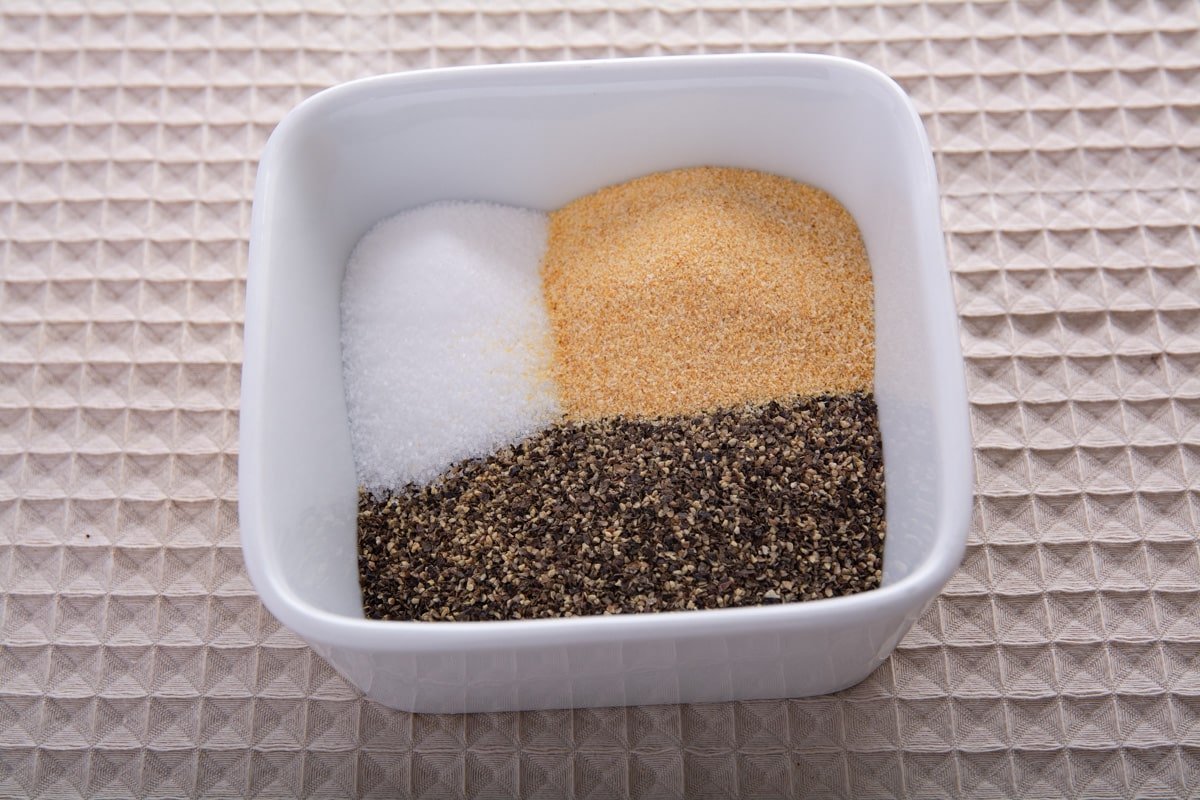
Brisket rub recipe
When it comes to beef, I like to keep things straightforward but oh-so-savory. If it’s good enough for some of the most famous pit masters, it’s definitely good enough for me. But, as always, feel free to get creative and experiment to make it your own!
Here’s what you need:
1. Black Pepper: I prefer coarse ground black pepper, but you can mix in some white pepper for a twist.
2. Salt: Yep, salt is a must. Normally, kosher salt is the go-to choice, but if you don’t have any, regular table salt works just fine.
3. Granulated Garlic: Or you can go with garlic powder for that wonderful garlicky kick.
Optional Ingredients:
- Onion Powder: It’s a great choice to add some depth of flavor.
- Brown Sugar: Some folks like it for pork, but I typically skip it for beef rubs.
- Chili Powder or Cayenne Pepper: If you’re up for a bit of heat and an extra burst of flavor, these are great options to consider.
Feel free to mix and match these ingredients to create a rub that’s perfect for your taste buds. After all, the joy of barbecue is in making it your own!

Here’s the deal, folks – we’ve got a nine-pound brisket straight from Costco. Now, I’m a big fan of buying brisket from Costco because they offer prime cuts at pretty much the same price my local grocery store sells choice brisket. It’s a win-win!
Now, this here is the fat side, and it usually comes with a nice, thick fat cap. To avoid any fiery flare-ups in my cooker, I grab a sharp knife and get to work. I trim off as much of that silver skin and excess fat as I can. But let me be honest with you, I’m not a trimming expert, and that’s totally okay. The end results still turn out mighty fine. So don’t stress too much about making it look perfect.
Once I’ve got it all trimmed up, I lay the brisket on a sheet pan. Why, you ask? Well, because what comes next is a bit messy. I’m talking about using a meat injector to get that flavor deep into the meat. Especially on a smaller brisket like this, not all of the marinade stays inside. So, I just jab the brisket, inject some, move to another spot, and repeat the process. Keep at it until you’ve given most areas a flavorful boost. Then, grab some trusty paper towels to pat that meat dry. Now, we’re cooking!
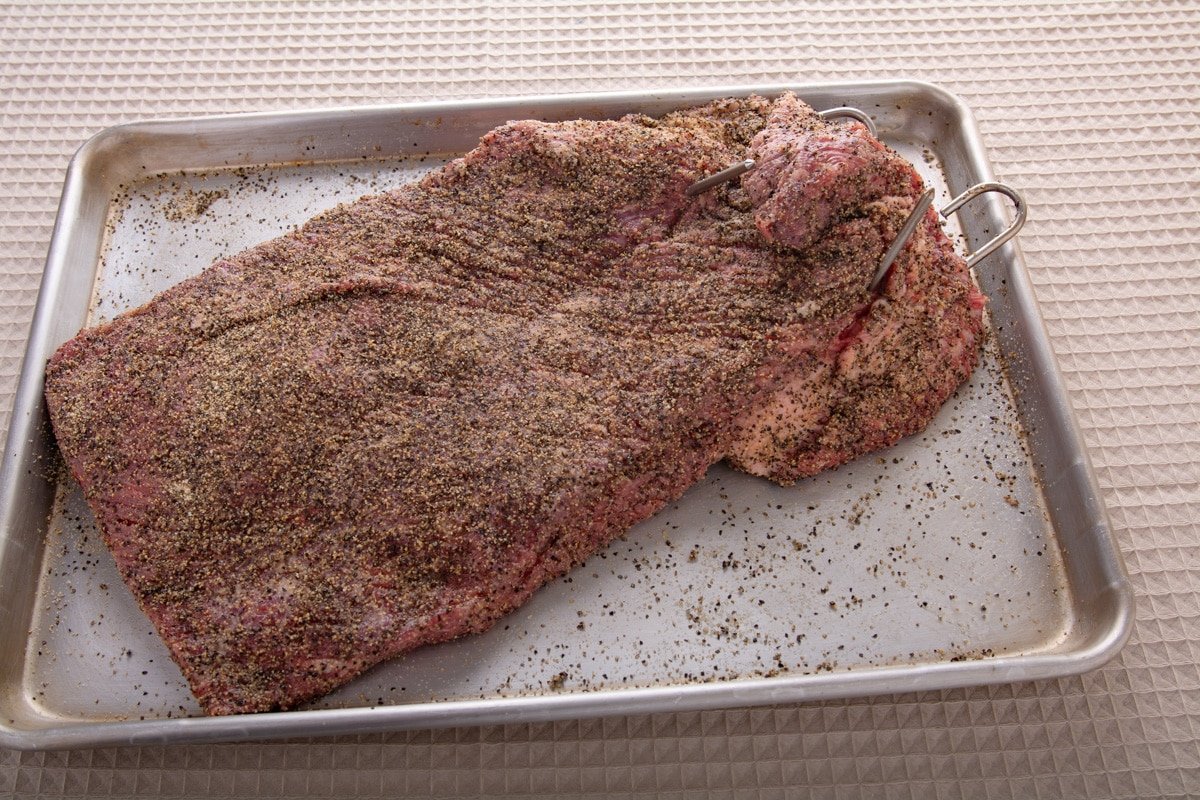
Alright, it’s time to give that meat a little pre-cook TLC. I personally like using olive oil as my binder, but I’ve seen folks use mustard or even mayonnaise. Olive oil keeps it simple and doesn’t mess with the flavor.
Here’s the drill: take about a tablespoon of olive oil and generously spread it all over both sides of the brisket. Get it nicely coated.
Now, let’s talk seasoning. Get ready to lay it on thick – brisket can handle it! The general rule of thumb here is to add more seasoning than you think it needs. Remember, brisket is a hefty cut of meat, and that heavy seasoning is what gives you that glorious bark.
For this cook, I usually do this step a few hours ahead of time and then pop the meat back into the fridge. About an hour before you’re ready to start cooking, take it out of the fridge. It’s all about building up that mouthwatering flavor, my friend!
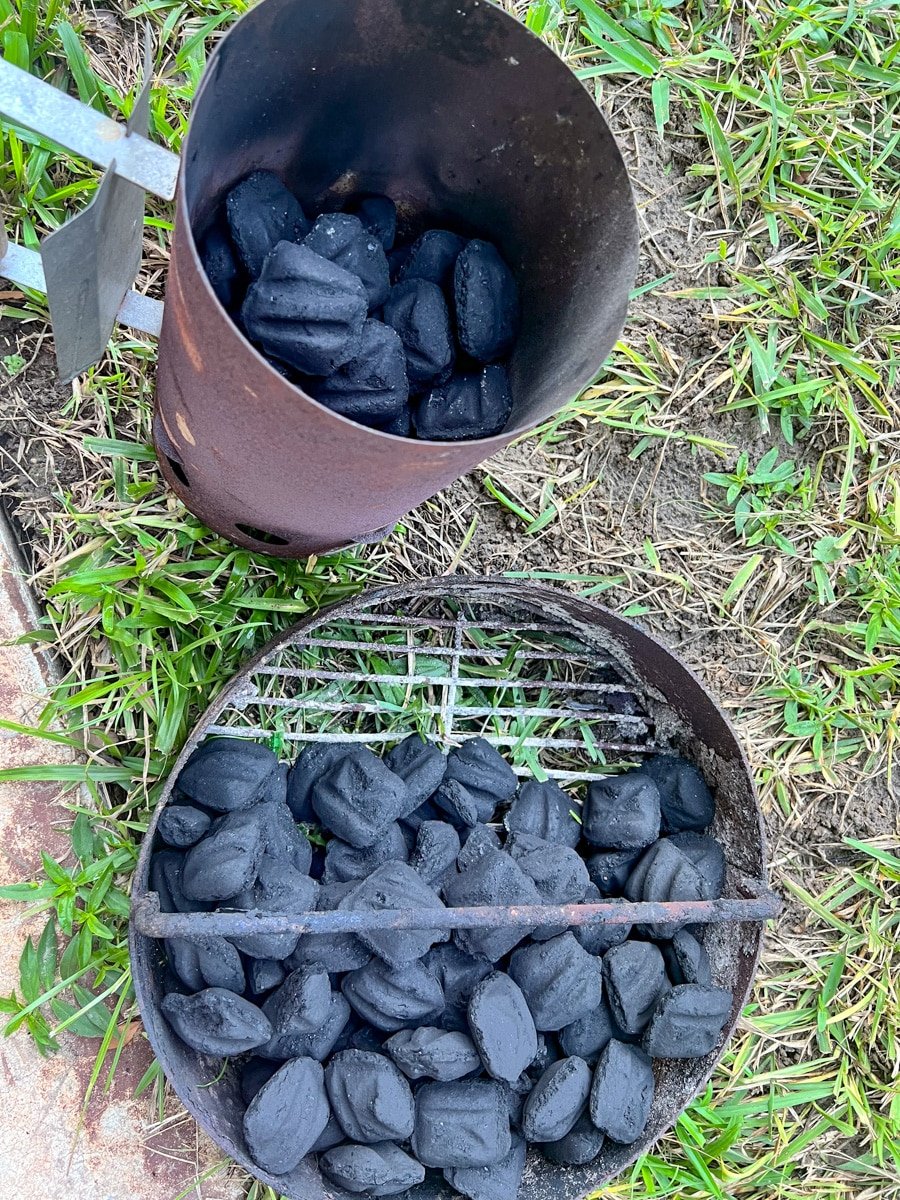
Now, let’s get that fire going in your cooker! If you’ve checked out my pulled pork recipe you’ll find a good explanation of how I set up my cooker for those long, flavorful cooks. Right before I get everything fired up, I’ll take the meat out of the fridge and slide those hooks through a nice, thick part of the brisket.
To achieve a beautiful smoke ring (not for flavor, just for looks), keep the barrel temp as low as possible until the meat’s internal temperature reaches 145 degrees F. The magic happens when the brisket is on the hooks and the lid is closed.
To keep a watchful eye on the barrel temp and the meat’s temp, I rely on a trusty meat thermometer that sends the info straight to a receiver. My old one’s a champ, but I’ve got my eye on those fancy new Meater units.
Now, here’s the secret to brisket nirvana: long, slow cooking. There’s no exact time, but for the best results, plan on 8 to 10 hours for a small brisket. We’re talking about letting that fat render, the connective tissue and muscle fibers breaking down to tender perfection.
If you’re into basting (I skip it with the Pit Barrel Cooker), grab a spray bottle, fill it with equal parts apple juice and water, and give the entire brisket a misting every hour.
Keep that brisket hanging on the rods until the internal temperature hits 160 to 165 degrees F. At this point, there’s a risk of it falling off the hooks, so it’s time to move it to the gates. Take the brisket out, add the grill grate, and here’s the choice: if you’re happy with the bark, wrap it up in butcher paper or aluminum foil and place it on the grill grate. If you want more bark, just let it be unwrapped – you can always wrap it up later. Continue cooking until you reach your desired internal temperature. For me, 200 degrees F usually does the trick.
If you run out of fire in the cooker, no worries. You can add more burning charcoal, or if needed, take the brisket inside and finish it in the oven. A wrapped brisket won’t absorb any more smoke flavor at this point; you just need a heat source. I wouldn’t be surprised if a lot of BBQ joints finish them in the oven.
At 200 degrees F, give the brisket a little shake to see if it giggles. If it does, that’s your sign that it’s done.
After all that mouthwatering anticipation, your brisket is ready to shine. Pop the whole thing into a cooler and let it rest for about an hour before slicing. And when you’re slicing, remember that brisket has two sections, and the grain runs differently in each. So, as always, slice against the grain for that perfect bite. 🍖🔥✂️ Enjoy!
Hey there, barbecue enthusiast! If you’ve had your fill of brisket (or maybe it’s just hibernating for the season), you might want to take a little detour and check out my smoked chuck roast recipe. It’s like the brisket’s quirky cousin – still packed with flavor, but with a personality all its own. Who knows, you might just fall head over heels for Chuck Roast’s smoky charms! 😄🍖🔥
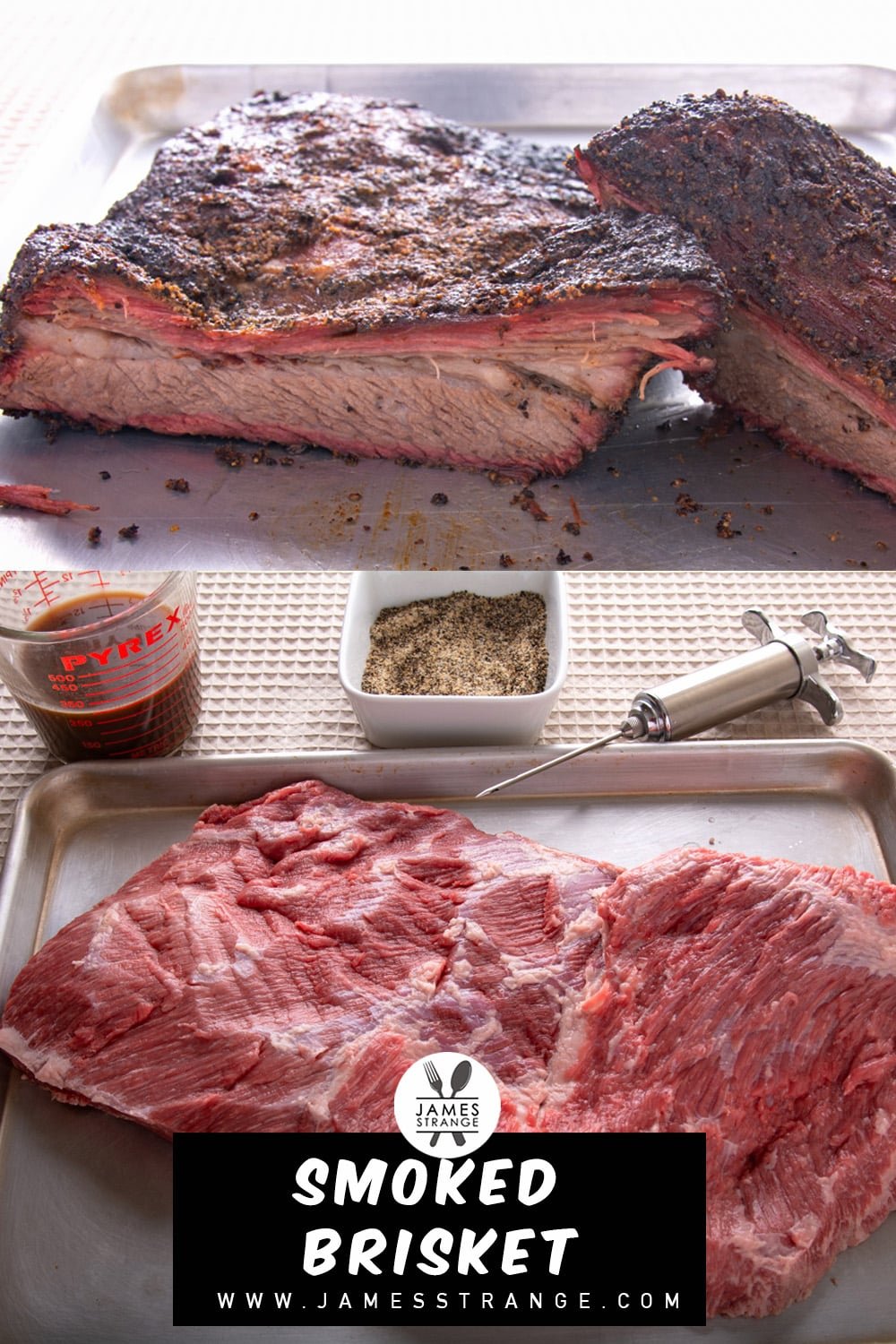
If this recipe tickled your taste buds and put a smile on your face, then be a BBQ hero and share it with your pals! After all, what are friends for if not for passing along mouthwatering secrets? Let’s spread the smoky love, one taste bud at a time!
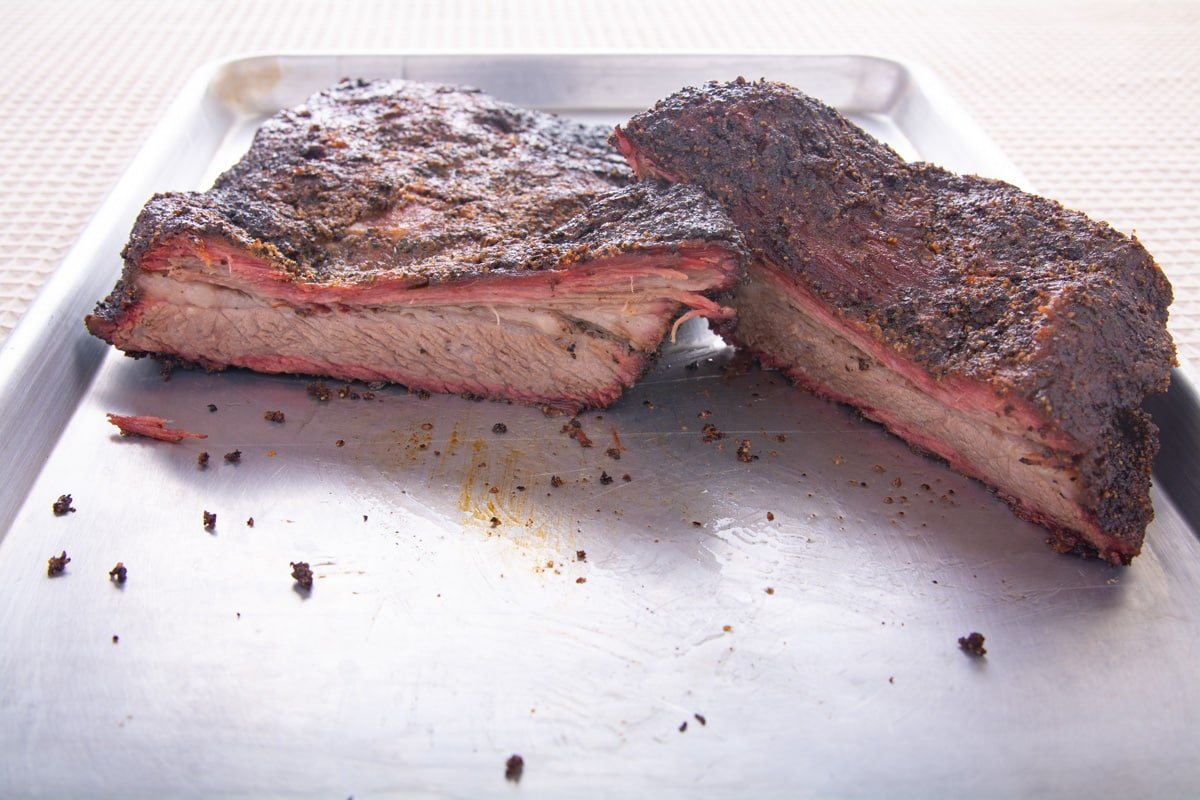
Ingredients
- 9 pounds Beef brisket
- 2 Tablespoons Olive oil
Rub
- 1/4 Cup Black pepper
- 2 Tablespoons Salt
- 2 Tablespoons granulated garlic
Injection marinade
- 1 Cup Water
- 2 teaspoons Beef base
- 1 teaspoon Soy sauce
- 1 teaspoon Worcestershire sauce
- 1/4 teaspoon Fish sauce
Instructions
Make the rub
- Mix rub ingredients; black pepper, salt, and granulated garlic.
Make the injection marinade
- Mix injection marinade ingredients. Water, beef base, soy sauce, Worcestershire sauce, and fish sauce.
Cook
- Trim excess fat and silver skin from the outside of the brisket.
- Rub 2 Tablespoons of olive oil onto the outside of the meat.
- Spread the rub to cover the entire surface of the meat.
- Start a fire and prepare the cooker. Target temp of 225 to 250F.
- Hang the brisket form the rebar. Cook to an internal temperature of 165F.
- Remove the brisket and wrap it in butcher paper. Install the grate and place the wrapped brisket on the grate.
- Cook to an internal temperature of 200 to 205F.
- Remove the brisket from the cooker and place into an icechest. Allow to rest for one hour.
- Slice against the gran and serve.